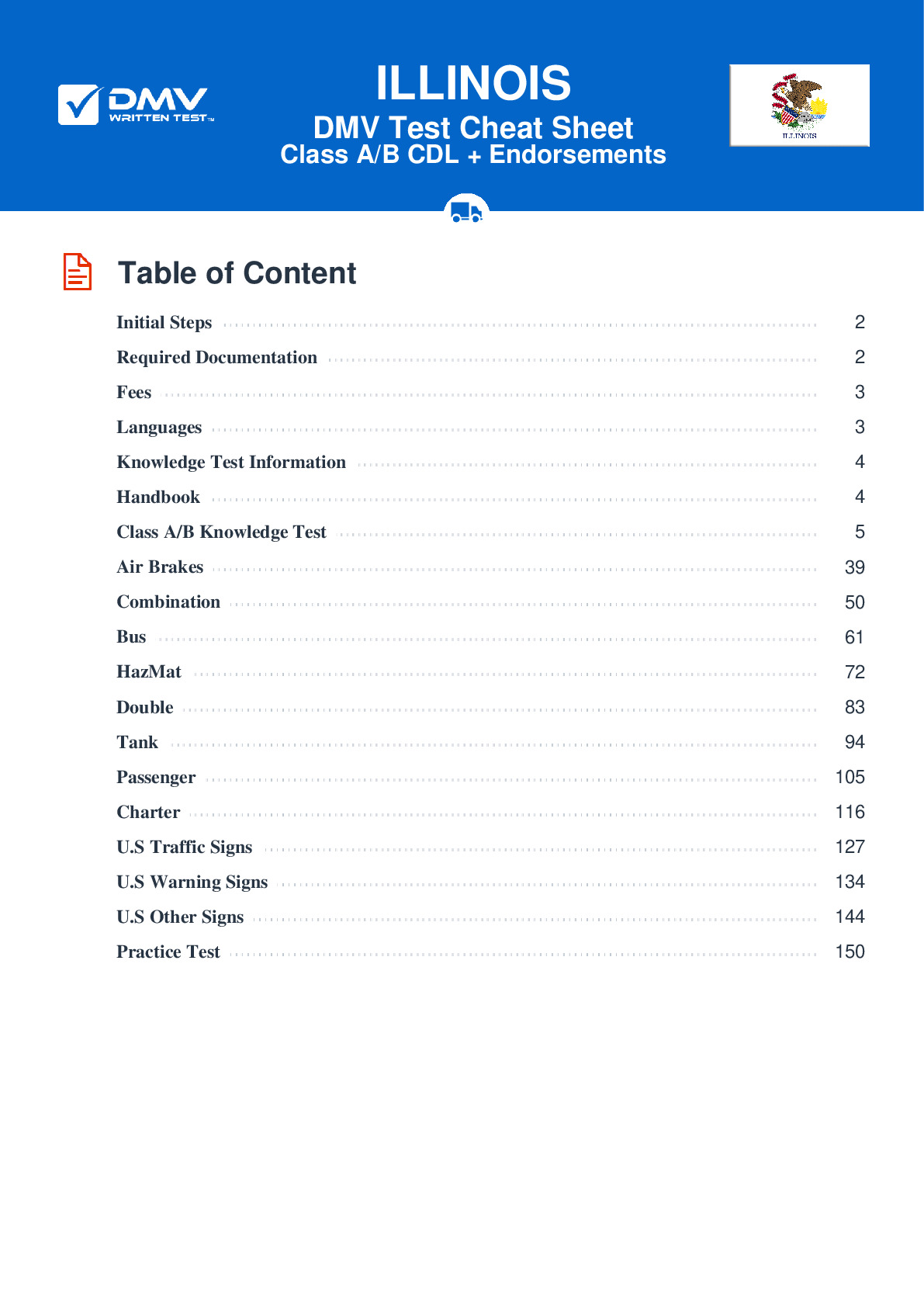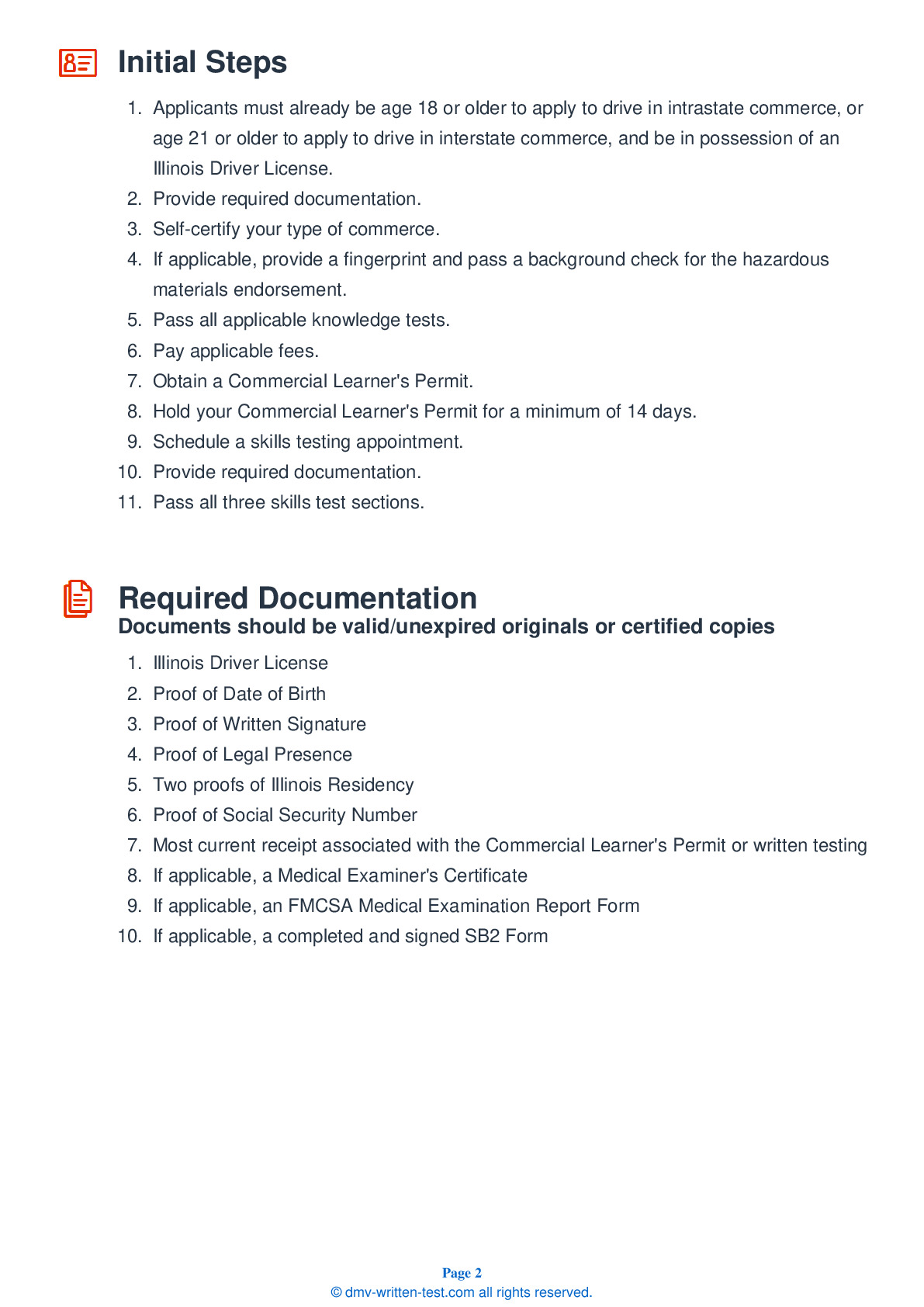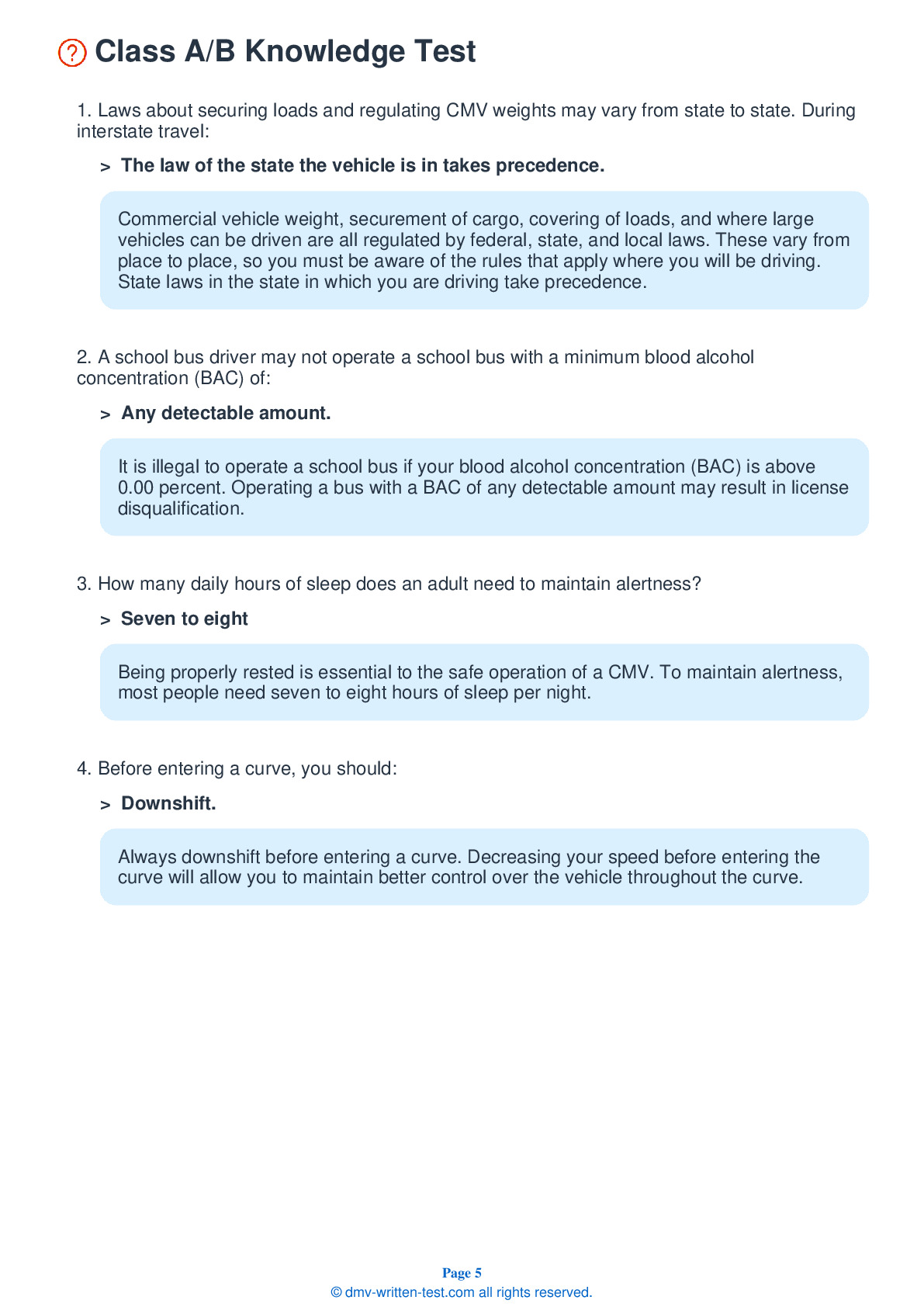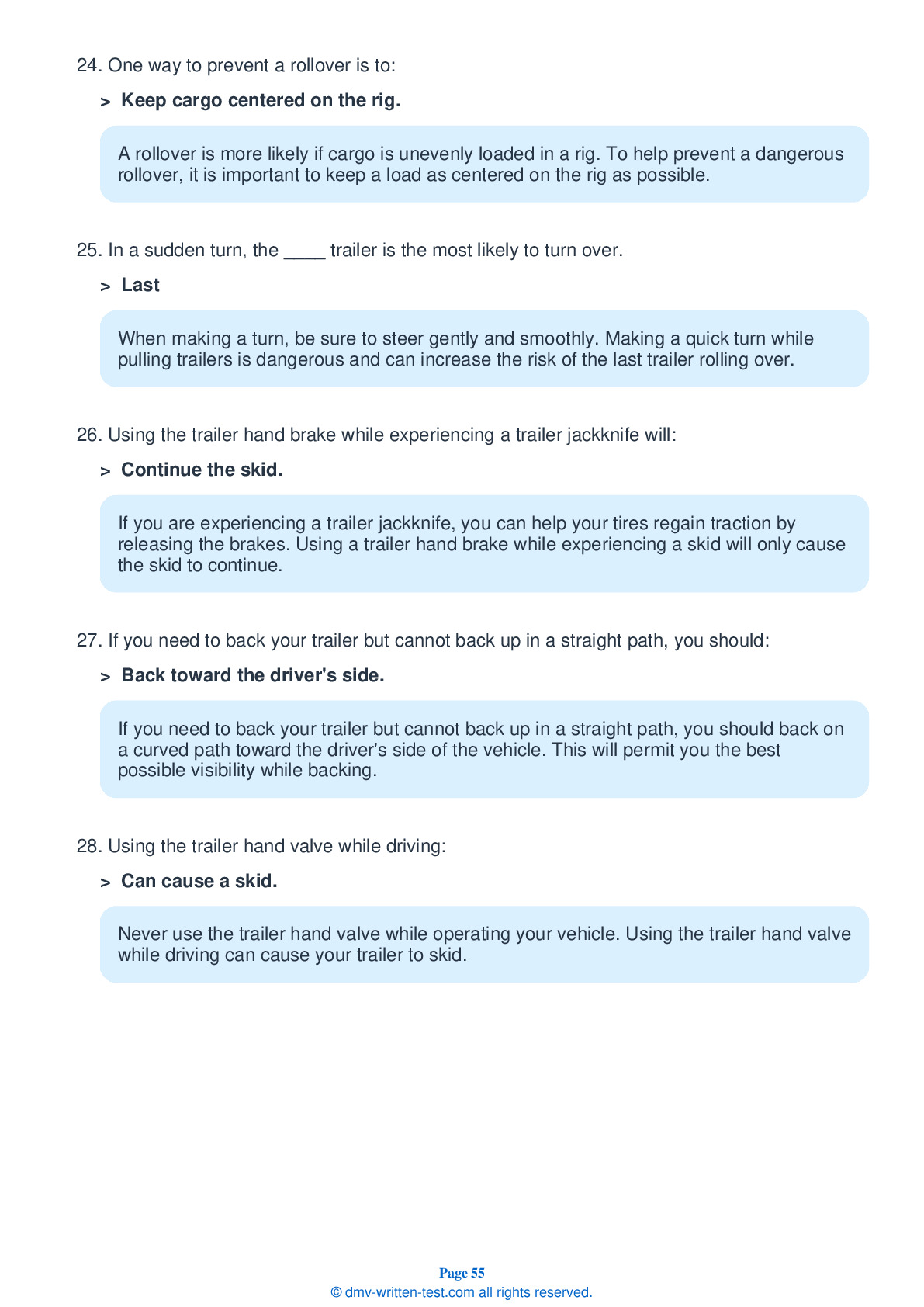Knowledge Test Class B
This license is required for driving a single vehicle with a GVWR of more than 26,001 pounds, and a trailer not to exceed 10,000 pounds gross vehicle weight rating, or a vehicle designed to transport 24 or more people (including the driver). To receive this license, applicants must pass a 50-question test. To pass, applicants must answer 40 questions correctly. Test questions come from the Illinois Commercial Drivers License Study Guide. Questions come from chapters covering: Introduction, Driving Safely, Transporting Cargo Safely, Air Brakes (if applicable), Combination Vehicles, Pre-Trip Vehicle Inspection Test, Basic Vehicle Control Skills Test and On-Road Driving. Endorsements that may be used with a Class B CDL are: Hazardous materials, Tank, Passenger, HazMat and Tank, Air Brakes, School bus and Charter.
8. How should you brake if your vehicle loses its ABS?
An Anti-Lock Braking System (ABS) is in place as an addition to a braking system. It intervenes to prevent brakes from locking up during hard braking. If ABS is not working, the basic braking functions on a vehicle will still remain, so the driver can continue to drive and brake normally.
9. How can a person check for a leak in hydraulic brakes?
Check hydraulic brakes by pumping the brake pedal three times before applying firm pressure to the pedal for five seconds. The pedal should not move. If it does, there may be a leak or some other problem in the braking system.
10. How much water needs to be on the surface of a road for a vehicle to hydroplane?
Hydroplaning is an effect in which a vehicle's tires lose traction with the surface of the road and instead glide along a layer of water. There does not have to be much water on the road for this to occur.
11. During the straight line backing exercise, how many times are you permitted to exit the vehicle to check its position?
During the straight line backing exercise, you are permitted to exit your vehicle to check its position no more than one time.
12. The use of hand-held cell phones while driving:
In Illinois, the use a hand-held cell phone or other communication device while operating a motor vehicle is prohibited.
13. When doing an inspection, make sure your brake pads are:
Potential problems to check for when inspecting brakes include cracked drums; shoes or pads with oil, grease, or brake fluid on them; and shoes that are missing, broken, or worn dangerously thin.
14. When inspecting cargo, the driver should do all of the following, except:
Cargo should be inspected by a driver to ensure that it is properly secured, balanced, and not exceeding weight limits.
Frequently Asked Questions
Here are the steps to obtain a Class B CDL license in Illinois:
1. Obtain and read the Illinois Commercial Driver's License Study Guide.
2. Obtain and hold a valid Illinois driver's license.
3. Meet the medical requirements by passing a physical examination and obtaining a Medical Examiner's Certificate.
4. Obtain a Commercial Learner's Permit (CLP) by passing the written general knowledge test, as well as any other additional tests required for specific endorsements (such as passenger or hazardous materials endorsements).
5. Practice driving with your CLP for at least 14 days before taking the road skills test.
6. Schedule an appointment with an approved CDL testing facility to take the road skills test, which includes a pre-trip inspection, basic control skills test, and an on-road driving test.
7. Pass all portions of the road skills test.
8. Pay all required fees and obtain your Class B CDL license.
It is important to note that additional endorsements may be required for specific types of Class B vehicles or cargo, such as tanker vehicles or double/triple trailers. Additionally, maintaining a Class B CDL license requires regular medical evaluations and compliance with all state and federal regulations related to commercial driving.
1. A single vehicle with a gross vehicle weight rating (GVWR) of 26,001 pounds or more.
2. A combination of vehicles with a total GVWR of less than 26,001 pounds, but with a towed vehicle that has a GVWR of more than 10,000 pounds (such as a large trailer or other equipment).
3. Vehicles designed to transport 16 or more passengers (including the driver) such as buses or vans used for public transportation or school buses.
4. Vehicles used to transport hazardous materials in quantities requiring placards.
It is important to note that additional endorsements may be required for specific types of vehicles or cargo, such as tankers or double/triple trailers. Additionally, it is important to comply with all state and federal regulations related to commercial driving and maintain a good driving record while holding a Class B CDL license.
1. You must be at least 18 years of age to drive within the state of Illinois or 21 years of age to drive across state lines or transport hazardous materials.
2. You must have a valid Illinois driver's license.
3. You must pass a Department of Transportation (DOT) physical exam and obtain a Medical Examiner's Certificate.
4. You must pass the written tests, which include the general knowledge test and any additional tests required for specific endorsements, such as passenger or hazardous materials endorsements.
5. You must obtain a Commercial Learner's Permit (CLP) by passing the written tests.
6. You must hold your CLP for at least 14 days before taking the road skills test.
7. You must pass the road skills test, which includes a pre-trip inspection, basic control skills test, and an on-road driving test.
8. You must pay all required fees and obtain your Class B CDL license.
It is important to note that additional endorsements may be required for specific types of vehicles or cargo, such as tankers or double/triple trailers. Additionally, it is important to comply with all state and federal regulations related to commercial driving and maintain a good driving record while holding a Class B CDL license.
1. Passenger (P) endorsement: This is required for drivers who plan to operate vehicles that are designed to transport 16 or more passengers, including the driver.
2. School Bus (S) endorsement: This is required for drivers who plan to operate a school bus.
3. Tanker (N) endorsement: This is required for drivers who plan to operate a vehicle that transports liquids or gases in tanks that have a capacity of 1,000 gallons or more.
4. Hazardous Materials (H) endorsement: This is required for drivers who plan to transport hazardous materials, which are defined by the federal government as substances or materials that pose a risk to public safety or the environment.
5. Combination Tank and Hazardous Materials (X) endorsement: This is required for drivers who plan to transport both hazardous materials and liquids or gases in tanks.
It is important to note that obtaining endorsements typically requires passing additional written tests and meeting certain requirements beyond those needed for a standard Class B CDL license.
1. Pre-trip inspection: In this part of the test, you will be asked to inspect your vehicle and identify any potential safety hazards. You will be required to check the brakes, steering, lights, tires, and other important components of the vehicle. You must demonstrate your knowledge of the vehicle and how to identify any issues that may prevent it from operating safely.
2. Basic vehicle control: In this part of the test, you will be asked to demonstrate your ability to control the vehicle in a variety of situations. You may be asked to perform tasks such as straight-line backing, offset backing, parallel parking, and docking. You must demonstrate your ability to maneuver the vehicle safely and accurately.
3. On-road driving: In this part of the test, you will be asked to drive on public roads while being evaluated by an examiner. During this portion of the test, you must demonstrate your ability to operate the vehicle safely and obey traffic laws. The examiner will evaluate your ability to make turns, change lanes, maintain proper speed and following distance, and respond appropriately to traffic signals and signs.
Overall, passing the Class B CDL skills test requires a strong understanding of commercial driving techniques and a commitment to safety on the road.
1. Vehicle weight limitation: Drivers with a Class B CDL license are limited to operating vehicles with a Gross Vehicle Weight Rating (GVWR) of 26,001 pounds or more. If the vehicle being operated has a GVWR of less than 26,001 pounds, but is designed to transport 16 or more passengers (including the driver) or hazardous materials, a Class B CDL with the appropriate endorsements is still required.
2. Towing limitation: Drivers with a Class B CDL license are allowed to tow vehicles with a GVWR of up to 10,000 pounds.
3. Passenger limitation: Drivers with a Class B CDL license are allowed to transport up to 16 passengers (including the driver).
4. Endorsement requirements: Drivers with a Class B CDL license may be required to obtain certain endorsements in order to operate specific types of vehicles or transport certain types of cargo.
It is important for drivers to be aware of any restrictions or limitations on their Class B CDL license in order to ensure compliance with state and federal regulations and avoid any potential penalties or violations.
In order to take the written test in a language other than English, you must inform the Secretary of State's office when you schedule your appointment. You may be required to bring a qualified interpreter with you to assist with the testing process.
It is important to note that while taking the written test in your native language may be helpful, it is still important to have a solid understanding of English for communication purposes on the road and for understanding road signs and signals.
1. Extended testing time
2. Large-print or Braille test materials
3. Audio or oral testing
4. Use of a reader or scribe
To request accommodations for the Class B CDL written test, you must inform the Secretary of State's office when you schedule your appointment. You will be required to provide documentation of your disability and the specific accommodations you require.
It is important to note that accommodations must be requested in advance, and may take some time to arrange. To ensure that you receive the necessary accommodations, it is recommended that you make your request as early as possible before your scheduled test date.
If you fail the written test on your first attempt, you may retake the test the next business day. If you fail the test a second time, you must wait at least 7 days before retaking it. If you fail the test a third or subsequent time, you must wait at least 15 days before retaking it.
It is important to note that there is a fee for each attempt at the written test, and these fees are non-refundable. Therefore, it is recommended that you thoroughly study and prepare for the exam before taking it to increase your chances of passing on your first attempt.




